Understanding Hypothermia
Back when I was young, when someone got lost in the woods and was found dead three weeks later the cause of death was usually listed as “exposure.” I didn’t know what that meant, and neither did anyone else. Nowadays we would more accurately ascribe most such deaths to hypothermia, a wilderness emergency with well-defined causes, means of prevention, and, in a worst-case scenario, treatment.

Snow in spring turkey season? It can happen. Always go prepared for the worst weather you might encounter.
Humans, like all mammals, are poikilotherms—warm-blooded machines designed to operate within a very precise temperature range. When the temperature of the human body core drops below 95 degrees (in this article all temperatures are expressed in degrees Fahrenheit) or above 105, things fall apart quickly and death is likely without intervention. The first situation concerns us here.
The body is a furnace that produces heat by burning fuel, just like an oil stove. Our operating temperature represents a balance between the rate at which heat is generated and the rate at which it is lost. A number of regulatory mechanisms (like sweating) help dispel heat when the ambient temperature is high, while others (like shivering and redistributing blood flow toward the body core and away from the extremities) help produce and conserve heat when the ambient temperature is low. When the latter can’t keep pace with the rate of heat loss, hypothermia develops. Unchecked, it can be lethal.
It’s important to understand two things that hypothermia is not. When ears, toes, and fingertips freeze in extreme cold, that’s frostbite. Significant tissue damage may occur, but it’s a different problem. And hypothermia doesn’t mean feeling really cold when you’re sitting in a stand on a November deer hunt. If you thought you were developing hypothermia because you were shivering hard, you almost certainly weren’t. Hypothermia victims lose their ability to feel cold, can’t think clearly, and eventually stop shivering altogether.
Here is a brief summary of what happens when body temperature falls below its normal range, by degrees of core temperature (this term refers to temperature in the center of the body, which may be higher than that in the extremities):
- 95°—Maximum shivering—a reflex attempt to raise the body temperature by burning metabolic fuel.
- 93°—Forgetfulness and poor judgment.
- 91°—Incoordination and increased urine production.
- 89°-90°—Shivering stops, depressed consciousness begins.
- 86°—Heart rhythm disturbances develop.
- 80°—Reflexes and voluntary motion disappear. Death becomes likely without medical intervention.
Preventing hypothermia begins with an understanding of the climactic conditions most likely to cause it. Remember that cold temperature alone doesn’t necessarily cause hypothermia. What matters is the rate at which the body loses heat. Two environmental factors contribute to heat loss just as much as cold air temperature: wind and moisture. You may be more likely to develop hypothermia on a wet, windy day with temperatures above freezing than on a calm, dry sub-zero day.
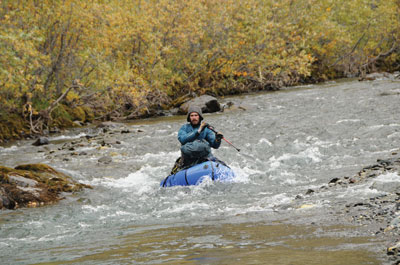
Yote Robertson pack rafting out of the North Slope. His Dad got dunked on this trip. Fortunately, we were prepared for it.
Nowadays, most of us are familiar with the concept of wind chill. Widely available tables can tell you, for example, that a 30 mph wind on a 30 degree day will make your body lose heat as if it’s 15 degrees and calm. The effect of moisture is a bit more complex. The process of evaporation consumes heat—that’s why you sweat on hot days. Moisture conducts heat away from the body much faster than air. Furthermore, most clothing loses some of its insulating ability when it’s damp. The degree to which that happens varies considerably among fabrics, an important consideration in the selection of outdoor clothing.
Since our clothes usually offer the first line of defense against conditions conducive to hypothermia, it’s important to realize that insulating ability isn’t the only factor to consider in their selection. A quality down coat rated to sub-zero temperatures won’t do much good if it is soaking wet and facing gale force wind. This leads to the concept of layering.
Lying next to the body, the primary purpose of the base layer is to wick heat-robbing moisture away from the skin. The cotton long underwear many of us wore as kids is a disaster, since cotton retains moisture rather than dispersing it. Silk is an effective natural fiber for this purpose, but it wears out quickly. No matter how “traditional” you feel about your clothing, the newer synthetic microfibers do a far better job of keeping the skin dry and reducing heat loss due to evaporation and conduction.
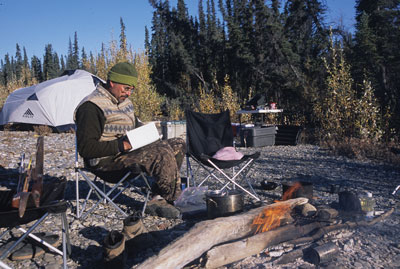
A wool vest makes a good addition to an Alaska packing list. A vest will cover approximately half of the body surface area where heat loss occurs.
The insulating layer comes next. This is a matter of R-factor, just like the insulation in your house. High quality down has the best ratio of insulation to weight of any natural fiber, but down clothing can be bulky, the nylon commonly used to contain the down is noisy, and traditional down is useless when wet. New treatment processes have created “hydrophobic” down that retains its loft and insulating ability when wet. Several friends are enthusiastic about it, although I have yet to test it myself. I have always loved good wool, which is quiet, insulates well, and retains much of its insulating ability when damp. The disadvantages of wool are that it retains moisture, weighs a lot (especially when wet), compresses poorly inside a pack, and takes forever to dry, as anyone who has hung a soaking wool coat over a woodstove knows. In the 1970s, DuPont produced the first synthetic insulation for clothes. Now a number of newer synthetic fibers insulate well without these disadvantages. Personally, I will always have a soft spot in my heart for high quality wool despite its shortcomings.
The outer barrier layer serves to protect the body and the inner layers from wind and rain and retain the warm air created by body heat. Oilcloth, rubberized fabrics, and nylon traditionally served this purpose. All did a reasonably good job of breaking the wind and keeping rain out, but they were bulky, noisy, and suffered from an essential flaw: the same fabric properties that kept moisture outside also kept it inside. If you were working hard enough to sweat, you were going to get damp one way or the other.
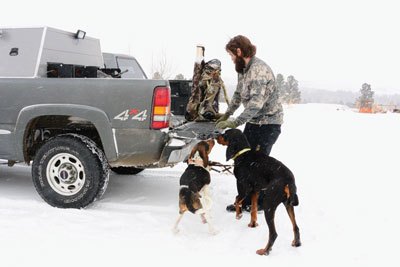
Lion hunting is always a challenge, since you heat up easily on the track but face winter weather conditions if you get stuck in the woods. Dress in layers and carry a good insulating layer in your pack.
Developed from fluropolymers in 1969, Gore-Tex changed the game. The idea was simple enough: create a fabric full of tiny holes small enough to keep water droplets out but large enough to allow water molecules suspended in air to escape, allowing clothes beneath it to “breathe.” Some early Gore-Tex clothing was noisy and allowed water to leak in along seams, but these problems have largely been solved by newer fabric technology.
Don’t forget the importance of a good hat. Because of its rich blood supply, the scalp can produce around 20% of the body’s heat loss to the environment.
Good judgment, awareness, and proper clothing should provide adequate protection from hypothermia in most hunting situations, but some call for more. This is especially true in places like Alaska, even though whitetail hunters from the upper Midwest may face colder temperatures at home. In the Far North, a number of factors acting together compound the risk of hypothermia on a hunt, including wind, rain, rugged terrain, travel by water, and the frequent need to cover long miles from a secure base camp. Let’s suppose, for example, that you have swamped a boat in the North Pacific, dinged the prop on an airplane in the middle of nowhere, run into a blizzard on horseback, or been cut off from camp by rising water near a river or tide flat. (All have happened to me.) What next?
As in any wilderness emergency, the response should begin with a quick damage assessment, an inventory of assets, and a prioritized list of hazards. To keep the discussion focused, let’s assume you’ve decided that protection from hypothermia is at the top of your list of concerns, as it should be in many situations. Remember the three environmental factors that contribute to heat loss: wind, moisture, and ambient temperature. Since the first is the easiest to address, I’d begin by identifying potential windbreaks, which might be as simple as a big tree or a shallow trench scraped out behind a log.
If you are dry, staying dry should be a priority. Identify potential sources of shelter from rain (evergreen trees, an overturned boat, a raincoat or tarp if you have one) and don’t deliberately get wet by trying to wade a river unless you have a good reason to do so, like a cabin on the other side. Local knowledge of the places where unoccupied wilderness cabins and fish camps are located has helped me out before—something to think about before you leave civilization.
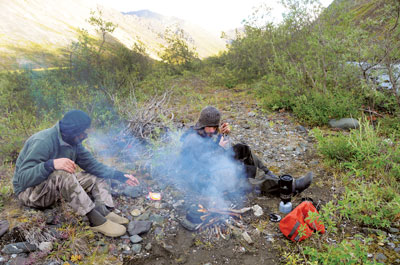
North Slope, Alaska. Campfires are great morale boosters, but they provide limited protection against hypothermia.
Jack London’s classic To Build a Fire is a great short story, but it unfortunately reinforces the mistaken notion that a fire is a high priority in the prevention of hypothermia. Of the three basic environmental factors that contribute to hypothermia, ambient temperature is the hardest to control. An open fire is a poor source of heat, and external heat has a limited role in the treatment of established hypothermia.
Once you have addressed higher priority concerns however, a fire can increase comfort level and boost spirits during an unplanned night in the woods. Its heating value will increase significantly if the fire is built against a reflective surface like a rock face or reflective blanket, or within a partial enclosure like a jumble of beach logs or a snow cave. There is no reason to build a fire so hot you can’t get close to it. Big fires consume fuel without doing much to keep you warm.
Years back, a Russian sable trapper taught me a neat trick when we unexpectedly faced a cold night in the woods with no shelter. We had plenty of wood, so we built a roaring fire that wouldn’t have done us much good by itself. While the wood was burning down to coals, we used sticks to scrape out a trench on the gravel bar where we’d bivouacked. Then we pushed the coals into the trench, covered them back up with several inches of gravel, and slept on top. I felt a bit like the pig at a luau, but the heat from the buried coals kept us comfortable throughout a potentially miserable, dangerous night.
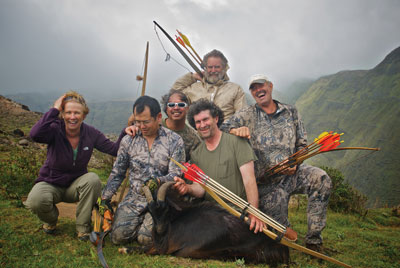
Yeah, it was Hawaii—but the wind was blowing 60 mph. Someone was smart enough to bring along a light barrier layer.
Hypothermia is a complex subject, and it’s impossible to cover the topic comprehensively in a short space. Perhaps we’ll discuss treatment of hypothermia in a future Backcountry column. Here is what you need to take away from this introduction:
- Understand the environmental conditions that lead to hypothermia, particularly wind and moisture.
- Prepare for unexpected conditions when you are hunting in an unfamiliar area, especially in the North.
- Wear or carry clothing appropriate to the worst conditions you might encounter.
- Understand the principle of dressing in layers, and wear clothing made from appropriate materials.
- Recognize the limitations and advantages of various fabrics, including the newer synthetics.
- Carry basic survival gear whenever you are in the field under actual or potential conditions capable of producing hypothermia.
Now enjoy the hunt—and keep your temperature gauge where it belongs.



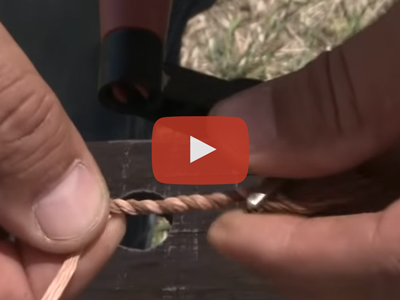
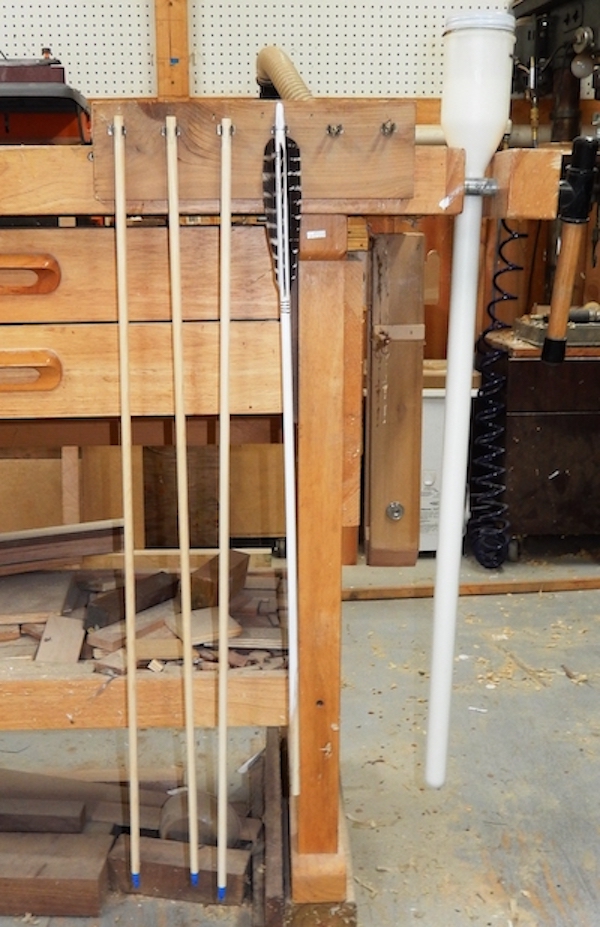


Attitude is also highly important! In 1968-9 I was an electronics tech on the White Alice Communications System in Alaska. During that time at the Indian Mountain site (I wasn’t there, but the report went out to all the sites), the site mechanic went caribou hunting with 2 Air Force people. They went down a draw in waist deep snow and one of the GIs broke a leg.
The mechanic told the other GI to go back up to the truck and go for help while he stayed with the injured fellow. The Air Force people had the standard issue cold weather clothes including thick parka and fat boy pants, bunny boots etc. The mechanic wore long underwear, wool shirt, wool jacket jeans and boots. The guy with the broken leg died. The mechanic said he tried to keep his spirits up but said he saw the kid just give up and, and shortly afterwards he was gone. Help arrived later that night.
I don’t remember any other details, whether they had a snow cave, a fire or anything else. The point is that the mechanic was fairly lightly dressed for the conditions and survived while the other person had clothes which should have kept him warm but didn’t, died. What was emphasized in the report was the attitude of both.
Thinking about it long after, and having used surplus AF winter gear, fatigue was probably a factor but still, the kid just giving up the will to live was paramount.
“Will to live,” or lack of it, are real phenomena, but I suspect something else may have been involved here given the short period of time between injury and death. A number of factors can make one person more susceptible to hypothermia than most. The victim may well have sustained injuries in addition to the obvious leg fracture. Even “just a broken leg” can cause enough blood loss—external or internal—to cause shock (a confusing and often misused term I’ll leave to another day). This is a sad story, but there is likely more to the grim outcome than attitude. Don
Quick correction: humans and other mammals are endotherms or homeotherms not poikilotherms.
I believe I responded to the last comment earlier. Ben Rich is entirely correct. My apologies for the error. I must have been having a senior moment. More and more of those these days! Don